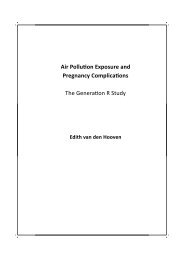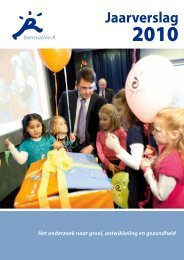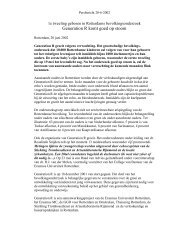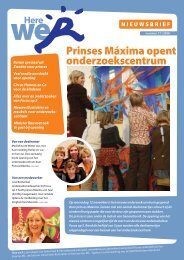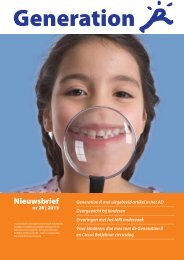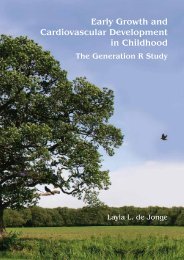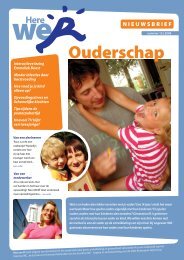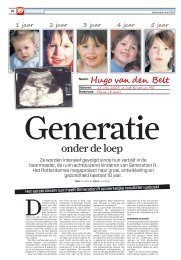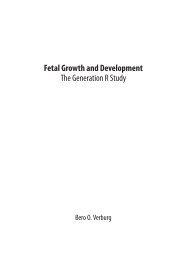Parents and infants: determinants of attachment in a ... - Generation R
Parents and infants: determinants of attachment in a ... - Generation R
Parents and infants: determinants of attachment in a ... - Generation R
Create successful ePaper yourself
Turn your PDF publications into a flip-book with our unique Google optimized e-Paper software.
Chapter 6<br />
neurological disorders, <strong>and</strong> 3) Children may develop atypical <strong>attachment</strong><br />
relationships due to both experience <strong>and</strong> child factors. These children may<br />
be more susceptible for the <strong>in</strong>fluence <strong>of</strong> contextual factors due to neurodevelopmental<br />
predispositions.<br />
The present study <strong>in</strong>vestigated whether disorganized <strong>attachment</strong> has a<br />
neurobiological component. We hypothesized that early structural differences<br />
<strong>in</strong> the gangliothalamic ovoid are related to later <strong>attachment</strong> disorganization.<br />
In contrast, we expected that early differences <strong>in</strong> general <strong>in</strong>dicators<br />
<strong>of</strong> bra<strong>in</strong> development, such as the volume <strong>of</strong> the lateral ventricles (Roza,<br />
Govaert, Vrooman, Lequ<strong>in</strong>, H<strong>of</strong>man, Steegers et al., 2008b) do not predict<br />
disorganized <strong>attachment</strong>. In addition, we exam<strong>in</strong>ed the role <strong>of</strong> contextual<br />
risk factors for disorganized <strong>attachment</strong> to test whether the gangliothalamic<br />
ovoid diameter predicts <strong>attachment</strong> disorganization <strong>in</strong>dependent <strong>of</strong> a set <strong>of</strong><br />
contextual risk factors.<br />
Method<br />
Study population<br />
This research was conducted with<strong>in</strong> <strong>Generation</strong> R, a population-based<br />
cohort from fetal life onwards <strong>in</strong> the Netherl<strong>and</strong>s (Jaddoe, Van Duijn, Van<br />
der Heijden, Mackenbach, Moll, et al., 2008). The study was conducted<br />
<strong>in</strong> accordance with the guidel<strong>in</strong>es <strong>of</strong> the World Medical Association<br />
Declaration <strong>of</strong> Hels<strong>in</strong>ki <strong>and</strong> was approved by the Medical Ethics Committee<br />
<strong>of</strong> Erasmus Medical Center. Written <strong>in</strong>formed consent was obta<strong>in</strong>ed from<br />
all adult participants. The study population consisted <strong>of</strong> 900 <strong><strong>in</strong>fants</strong> <strong>and</strong><br />
their parents who participated <strong>in</strong> the visit at the research center scheduled<br />
six weeks postpartum. This cohort was ethnically homogeneous (<strong>in</strong>digenous<br />
Dutch) to reduce confound<strong>in</strong>g <strong>and</strong> effect modification. All children<br />
were born between February 2003 <strong>and</strong> August 2005. Dur<strong>in</strong>g the 6-week<br />
visit, diameter <strong>of</strong> the gangliothalamic ovoid was successfully measured <strong>in</strong><br />
793 children. N<strong>in</strong>eteen children were excluded because they were tw<strong>in</strong>s<br />
<strong>and</strong> another 31 children because <strong>of</strong> lack<strong>in</strong>g measures <strong>of</strong> head circumference.<br />
Attachment classification at 14 months was available for 629 <strong>of</strong> the<br />
rema<strong>in</strong><strong>in</strong>g children (88% with the mother, 12% with the father). This group<br />
<strong>in</strong>cluded no children with known neurological illnesses. Data on the volume<br />
<strong>of</strong> the lateral ventricles was available 596 <strong>of</strong> these children.<br />
The group <strong>of</strong> <strong>in</strong>cluded children (n = 629) differed from the children<br />
who could not be <strong>in</strong>cluded due to miss<strong>in</strong>g data (n = 271) on the follow<strong>in</strong>g<br />
measures: Mothers <strong>of</strong> <strong>in</strong>cluded children were somewhat older (M = 32.0,<br />
108



